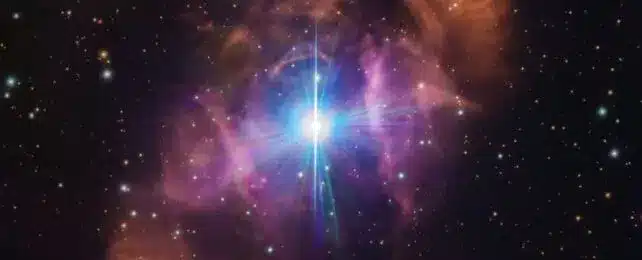What’s in today’s article?
- Why in News?
- What is a Nebula?
- What is the Dragon’s Egg Nebula?
- Unique Features of the NGC 6164/6165
- Significance of the Dragon’s Egg Nebula – A Window to Our Universe
Why in News?
- The nebula NGC 6164/6165, also known as the Dragon’s Egg, a cloud of gas and dust surrounding a pair of stars called HD 148937, have presented a puzzle to astronomers.
What is a Nebula?
- A nebula is a huge, expansive cloud of gas and dust that is found throughout the universe.
- This celestial formation comes in a variety of shapes, sizes, and colours, each with its own unique characteristics and story to tell.
- At its core, a nebula consists primarily of hydrogen and helium, the two most abundant elements in the universe.
- These gases intermingle with traces of heavier elements, such as carbon, nitrogen and oxygen, which were forged in the hearts of ancient stars.
- A nebula serves as the birthplace of stars.
- Within this cosmic cloud, gravity works tirelessly to pull the gas and dust together, slowly compressing the material into increasingly dense clumps.
- As these clumps grow in mass and density, their cores begin to heat up, eventually reaching temperatures high enough to ignite nuclear fusion.
- At this point, a new star is born, illuminating the surrounding nebula with its intense radiation.
- A nebula plays a crucial role in the life cycle of stars and galaxies.
- As stars form within this cosmic cloud, they gradually deplete the surrounding gas and dust, using it as fuel for their nuclear reactions.
- Over millions or billions of years, the most massive stars explode as supernovae.
What is the Dragon’s Egg Nebula?
- The Dragon’s Egg Nebula formed as a result of the intense stellar winds emanating from a massive, hot central star.
- NGC 6164/6165 consists of two distinct regions: NGC 6164, which represents the brighter, more compact area surrounding the central star, and NGC 6165, which extends outward in a series of complex filaments and bubbles.
- These two regions work together to create the nebula’s overall shape, which resembles a dragon’s egg – hence its popular name.
- The best views of NGC 6164/6165 come from powerful telescopes, such as the Hubble Space Telescope or the European Southern Observatory’s Very Large Telescope.
Unique Features of the NGC 6164/6165
- These two stars – gravitationally bound to each other in what is called a binary system – are located in our Milky Way galaxy about 3,700 light-years from Earth in the constellation Norma.
- A light-year is the distance light travels in a year, 5.9 trillion miles (9.5 trillion km).
- One of them has a magnetic field (as does our sun), while its companion does not.
- The magnetic star is about 30 times more massive than the sun. Its remaining companion is about 26.5 times more massive than the sun.
- They orbit at a distance from each other varying from seven to 60 times the distance between Earth and the sun.
Significance of the Dragon’s Egg Nebula – A Window to Our Universe
- The Dragon’s Egg Nebula serves as a reminder of the vastness and wonder of the universe. It represents just one of countless cosmic marvels waiting to be discovered and understood.
- As astronomers continue to study NGC 6164/6165 and other celestial objects, they unlock the secrets of the cosmos and expand our understanding of the fundamental processes that shape the universe.
Through the lens of the Dragon’s Egg Nebula, one can catch a glimpse of the intricate dance between stars, gas, and dust that plays out on a grand scale.
Q.1. What is the Hubble Space Telescope (HST)?
The HST was launched into low Earth orbit in 1990 and remains in operation. It was not the first space telescope, but it is one of the largest and most versatile, renowned as a vital research tool and as a public relations boon for astronomy.
Q.2. What is a supernova?
A supernova is a powerful and luminous explosion of a star. A supernova occurs during the last evolutionary stages of a massive star, or when a white dwarf is triggered into runaway nuclear fusion.
Last updated on December, 2025
→ Check out the latest UPSC Syllabus 2026 here.
→ Join Vajiram & Ravi’s Interview Guidance Programme for expert help to crack your final UPSC stage.
→ UPSC Mains Result 2025 is now out.
→ UPSC Notification 2026 is scheduled to be released on January 14, 2026.
→ UPSC Calendar 2026 is released on 15th May, 2025.
→ The UPSC Vacancy 2025 were released 1129, out of which 979 were for UPSC CSE and remaining 150 are for UPSC IFoS.
→ UPSC Prelims 2026 will be conducted on 24th May, 2026 & UPSC Mains 2026 will be conducted on 21st August 2026.
→ The UPSC Selection Process is of 3 stages-Prelims, Mains and Interview.
→ UPSC Result 2024 is released with latest UPSC Marksheet 2024. Check Now!
→ UPSC Prelims Result 2025 is out now for the CSE held on 25 May 2025.
→ UPSC Toppers List 2024 is released now. Shakti Dubey is UPSC AIR 1 2024 Topper.
→ UPSC Prelims Question Paper 2025 and Unofficial Prelims Answer Key 2025 are available now.
→ UPSC Mains Question Paper 2025 is out for Essay, GS 1, 2, 3 & GS 4.
→ UPSC Mains Indian Language Question Paper 2025 is now out.
→ UPSC Mains Optional Question Paper 2025 is now out.
→ Also check Best IAS Coaching in Delhi

















